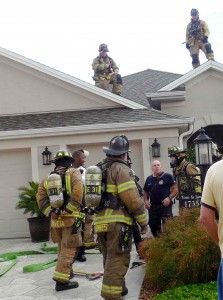
It seems fewer and fewer people are taking foolish chances when thunderstorms come up quickly around The Villages. As more and more people learn about the dangers of lightning, they are taking steps to assure their safety.
This safety trend is evidenced by more and more residents following golf course ambassadors’ suggestions to find shelter from impending storms. Villagers are leaving their golf carts unattended on site — on golf courses, in parking lots and elsewhere — to seek cover inside sturdy buildings. It is difficult to leave one’s golf game, horseshoe toss or nice cool swimming pool — but the list of lightning strikes in the area — to homes, to trees and to the ground — has gotten longer — giving us a strong signal to be wise and ‘get out of the way.’
For lightning rods to be effective, they must be properly grounded, to traffic any lightning strike safely into the ground. A roof ornament will not help us in a storm — only a properly installed lightning rod will.
For people who have an effective lightning protection system (LPS) on their home, a mega tester device can be used to measure whether the ‘ground’ meets national standards set by the National Fire Protection Association (NFPA 780) for resistivity of the driven ground rods. Because residential LPS are not regulated by any governmental agency, there are no mandatory inspections, but periodic maintenance is suggested.
“These systems have no mechanical moving parts,” lightning expert Len Hathaway says, “so generally speaking, they require very little attention. But they should not be ignored either.” Sunset Pointe Villager Hathaway and electrical engineer, Bob Freeman, who resides in the Village of Sanibel after retiring from a long ‘lightning’ career, suggest calling a qualified installer back every three to five years for routine checking. These technicians should be called immediately, however, if you believe your home was struck by lightning; if you’ve put an addition on your home, or if you plan to re-roof. Home additions would include a new pool cage, TV satellite dish, gravity-powered roof vents, solar tubes, solar panels, or a pergola. The experts also think it’s a good idea to have your LPS ground checked if you’ve recently had landscaping or excavation within three feet of your home’s foundation in the vicinity of the driven ground rods.
Lightning protection may differ in other parts of the U.S., but here in Central Florida, and particularly in the Sumter County portion of The Villages, a “Ufer ground’ is used, named after Hebert G. Ufer, a U.S. Army consultant who pioneered grounding of lightning protection systems in sandy desert soils during World War II. The Ufer ground has been approved by the National Electric Code (NEC) since 1968 for home electrical systems.
As part of new home construction, a steel rod is placed in the home’s slab in a horizontal position and connected to the steel rebar before the slab is poured. The ground rod protrudes through the slab just below the electric meter, with a ninety-degree bend extending upward for the electrician to connect the ground from the electric panel. “At this point,” Hathaway explained, “this has everything to do with electrical safety and nothing to do with lightning. The NEC does not address lightning.”
When a certified lightning protection system installer is called, he will drive the proper number of ground rods into the earth to meet the NFPA 780 standard. “Typically, this will be three or four eight-foot steel copper-clad ground rods located three feet from the slab — driven two feet below grade, and connected to the down conductors from the roof-mounted air terminals,” Hathaway continued. “Next, the installer must meet the standard for the proper resistance. In some cases, this may mean driving rods to a depth of perhaps thirty feet, depending on soil conditions. It is also the responsibility of the LPS installer to electrically bond the LPS to the home’s electrical system ground, the cable or satellite protection ground, the telephone protection ground, and any gas piping system ground — to assure all are at the same potential — to avoid a side flash.”
“You may find some door-to-door solicitors will skip this very important step,” Hathaway and Freeman warn. Fly-by-night installers often offer low prices and financial discounts or incentives if you get your neighbors and friends to sign up to do business with them. But without proper grounding, any system is a waste of time and money.
Since this is an unregulated ‘caveat emptor’ marketplace, nothing can be done to stop these bogus contractors. But buyers beware — it is critically important to select an installer who specializes in lightning protection systems, is listed with the Underwriters’ Laboratories, and whose technicians have passed the Lightning Protection Institute’s exams.
Lightning protection becomes a hot topic around The Villages whenever a home fire is started by a lightning strike or other lightning damage occurs. This has been a particularly active summer so far. On June 13, the Hickory Head Hammock gate was hit, followed by catastrophic house fires on June 15 in the Village of Pinellas and on July 23 in the Village of Lynnhaven. On June 23, a sewage spill in the Village of Palo Alto was triggered by lightning striking an oak tree near underground pipes. In August smaller fires, which The Villages Public Safety Department rapidly extinguished, were reported in the Villages of Bonita, Mission Hills and St. James.
People vary in their tolerance levels toward risk. Many cite statistics about how many Central Florida homes have NOT been hit by lightning. For those with less tolerance for risk, installing lightning rods may bring residents more peace of mind.
Len Hathaway (lhatha@aol.com) and Bob Freeman (STALIT1@aol.com) are happy to make an informative Powerpoint presentation upon request at any social, civic or religious group without charge. This service is a way these retired gentlemen volunteer their expertise and give back to their community.

